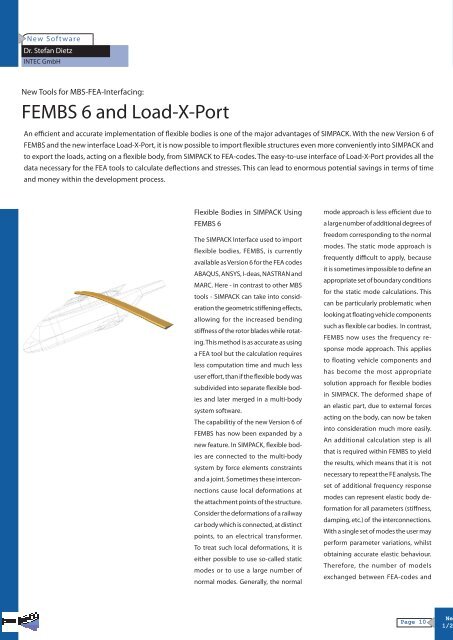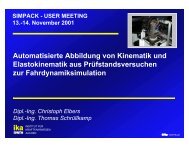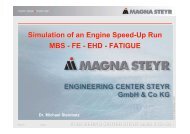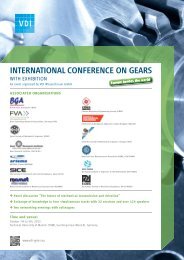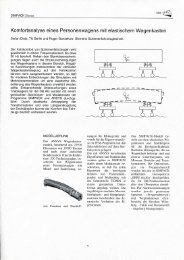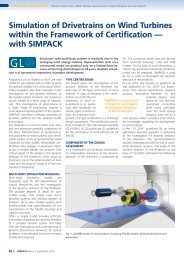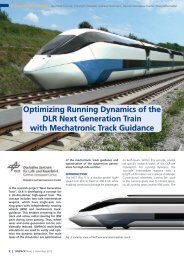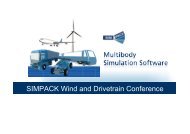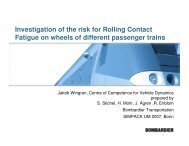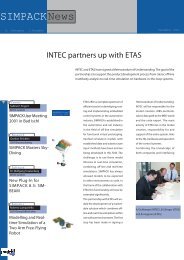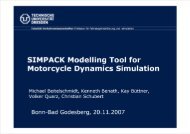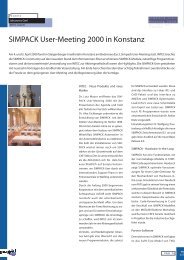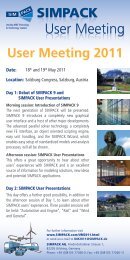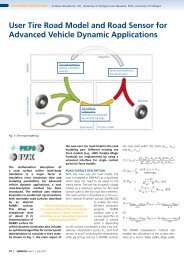SimpackNews
SimpackNews
SimpackNews
You also want an ePaper? Increase the reach of your titles
YUMPU automatically turns print PDFs into web optimized ePapers that Google loves.
New Software<br />
Dr. Stefan Dietz<br />
INTEC GmbH<br />
New Tools for MBS-FEA-Interfacing:<br />
FEMBS 6 and Load-X-Port<br />
An efficient and accurate implementation of fexible bodies is one of the major advantages of SIMPACK. With the new Version 6 of<br />
FEMBS and the new interface Load-X-Port, it is now possible to import fexible structures even more conveniently into SIMPACK and<br />
to export the loads, acting on a fexible body, from SIMPACK to FEA-codes. The easy-to-use interface of Load-X-Port provides all the<br />
data necessary for the FEA tools to calculate defections and stresses. This can lead to enormous potential savings in terms of time<br />
and money within the development process.<br />
Flexible Bodies in SIMPACK Using<br />
FEMBS 6<br />
The SIMPACK Interface used to import<br />
flexible bodies, FEMBS, is currently<br />
available as Version 6 for the FEA codes<br />
ABAQUS, ANSYS, I-deas, NASTRAN and<br />
MARC. Here - in contrast to other MBS<br />
tools - SIMPACK can take into consideration<br />
the geometric stiffening effects,<br />
al lowing for the increased bending<br />
stiffness of the rotor blades while rotat-<br />
ing. This method is as accurate as using<br />
a FEA tool but the calculation requires<br />
less computation time and much less<br />
user effort, than if the fexible body was<br />
subdivided into separate fexible bodies<br />
and later merged in a multi-body<br />
system software.<br />
The capabilitiy of the new Version 6 of<br />
FEMBS has now been expanded by a<br />
new feature. In SIMPACK, fexible bodies<br />
are con nected to the multi-body<br />
system by force elements constraints<br />
and a joint. Sometimes these interconnections<br />
cause local deformations at<br />
the attachment points of the structure.<br />
Consider the de formations of a railway<br />
car body which is connected, at distinct<br />
points, to an electrical transformer.<br />
To treat such local deformations, it is<br />
either possible to use so-called static<br />
modes or to use a large number of<br />
normal modes. Generally, the normal<br />
mode approach is less efficient due to<br />
a large number of additional degrees of<br />
freedom corresponding to the normal<br />
modes. The static mode approach is<br />
fre quently difficult to apply, because<br />
it is sometimes impossible to define an<br />
appropriate set of boundary con ditions<br />
for the static mode cal cu lations. This<br />
can be particularly problematic when<br />
looking at foating vehicle com ponents<br />
such as fexible car bodies. In contrast,<br />
FEMBS now uses the frequency re-<br />
sponse mode approach. This applies<br />
to floating vehicle com ponents and<br />
has be come the most appropriate<br />
solution ap proach for fexible bodies<br />
in SIMPACK. The deformed shape of<br />
an elastic part, due to external forces<br />
acting on the body, can now be taken<br />
into con sideration much more easily.<br />
An additional calculation step is all<br />
that is required within FEMBS to yield<br />
the results, which means that it is not<br />
necessary to repeat the FE analysis. The<br />
set of additional frequency re sponse<br />
modes can represent elastic body de-<br />
formation for all parameters (stiffness,<br />
damping, etc.) of the interconnections.<br />
With a single set of modes the user may<br />
perform para meter variations, whilst<br />
obtaining accurate elastic behaviour.<br />
Therefore, the number of models<br />
exchanged between FEA-codes and<br />
Page 10<br />
Ne<br />
1/2


